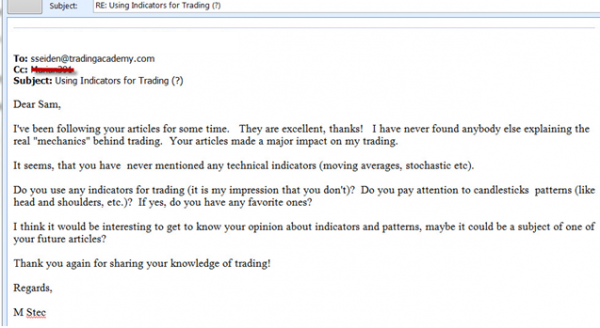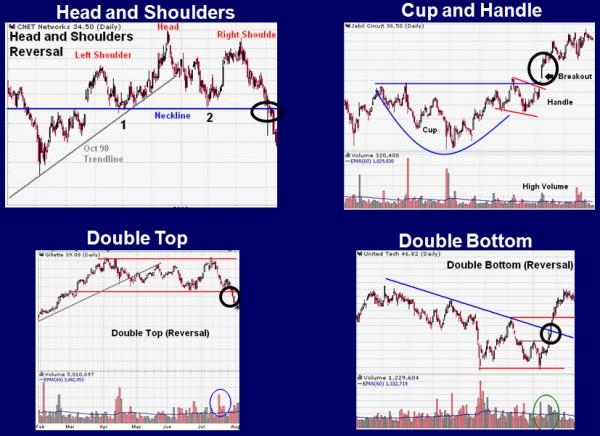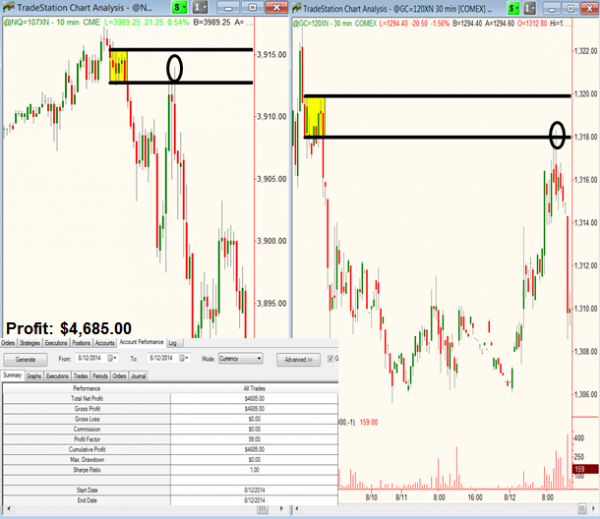![]()
I received an email with a question regarding my opinion of indicators and chart patterns. I began to reply to the email and then stopped. I thought, if this reader has this question, perhaps others do as well. Given that many short term traders lose money and that most long term investors never come close to achieving their long term financial goals, I felt it was my responsibility to give my honest opinion of conventional chart patters and indicators from the world of technical analysis.
First, let me take you back to when I initially learned how the trading markets worked and how money is really made and lost in the markets. In short, how to properly speculate in markets. Starting on the floor of the Chicago Mercantile Exchange (CME), I was responsible for facilitating institutional order flow. Each morning I would take buy and sell orders from banks, institutions, money managers, hedge funds, and some retail traders. I would have huge buy (demand) and sell (supply) orders in front of me all day. Each day price would move from demand to supply and back again… Anyone who made money would be either buying where demand exceeded supply for a long position or selling short at price levels where supply exceeded demand. In other words, anyone I saw who made money trading and investing would be buying at wholesale prices and selling at retail prices, period. People who lost money simply took the opposite action.
Fast forward to today, nothing has changed, this is and will always be how you make money buying and selling anything. This picture of bank and institution demand and supply is exactly what we teach our students to see on price charts so they can buy at wholesale prices and sell at retail prices. Anyway, this is how I learned to trade and this is exactly what my brain is focused on, really buying low and really selling high.
Months into my career at the CME, I was walking to lunch with a friend of mine from the trading floor. He said, “The markets are going to go higher tomorrow.” I said, “Oh, why?” He replied and told me the Stochastics were doing this and the MACD was doing that and so on. We were on our way to lunch so when he said MACD, my first thought was Mc Donalds because I was hungry. I stopped him mid sentence and told him I didn’t understand what he was talking about. I had never heard of any of that stuff. He said, “Technical analysis.” I said, “What’s that?” He explained a bit but I didn’t understand and I was more focused on getting lunch… A few days later, he took me into the CME library and showed me a technical analysis book. I flipped though it for the first time and my first thought was how ridiculous the information was. I looked at him and asked, “Who would use these strategies?” My friend said, “Everyone.” To illustrate why I thought that way, take a look at the chart patterns below that are in just about every trading book ever written. The Head and Shoulders, Cup and Handle, Double Top, and Double Bottom. There are many more but I thought I would share the most popular ones in the history of conventional technical analysis.
Conventional Chart Patterns
When you look at all these, notice the circled areas. The circles represent where the entry points are for these patterns. The big question is this, what do they all have in common? Notice they all have you buying AFTER a big rally in price and selling AFTER a big decline in price! In my world and any one I knew that made money trading, we did exactly the opposite and still do today. To me, all the information in the book was a recipe for losses, not gains. Why in the world would you wait for price to rally that much before buying or wait for such a big decline (or any decline at all) before selling? This made absolutely no sense to me. I was conditioned to do the opposite from my experience in real work trading and investing.
During the years that followed, I really began to understand why most active retail traders lose money and why most long term investors never achieve their financial goals. It’s because they are taught completely backwards. In fact, everything in this book had you buying after a rally in price and selling after a decline in price. You would never take that novice action when buying and selling anything else in life and profit and the financial markets are no different. Do you think Goldman Saches sits around looking for Head and Shoulder patterns? Do you think they make their billions in profits waiting for price to rally and form a Cup and Handle before buying? They laugh at the trading books just like we did on the trading floor.
Let’s take a look at two trades I took last week in our program to illustrate the point and so you can learn from it if you so choose. The yellow boxes represent supply levels (retail prices) where financial institutions are selling and have plenty of unfilled sell orders, our strategy rules tell us so. The circles represent the short entries where I sold to retail traders who were buying. Our rule based strategy also told us significant demand was not until much lower which offered a nice profit zone and risk/reward.
Nasdaq and Gold Income Trades, 8/12/14. Total Profit for day: $4,685.00
Had I added any indicators to this trading opportunity, none would have been giving sell signals at supply. When price reached supply for the short entry, every moving average is still pointing up and so on. None are giving sell signals at all. Once prices turn lower all the indicators begin giving sell signals but for me, that’s way too late to start selling as the risk is much higher and reward is reduced.
The key is to both think like a bank and institution and act like one when trading and investing. To make an already long story short, I don’t use indicators and oscillators in my trading and we don’t focus on them at Online Trading Academy. They lag price which means that if we add anything to our decision making process that lags price, we are only increasing risk and decreasing profit margin.
Hope this was helpful. Have a great day.
Note: All information on this page is subject to change. The use of this website constitutes acceptance of our user agreement. Please read our privacy policy and legal disclaimer. Opinions expressed at FXstreet.com are those of the individual authors and do not necessarily represent the opinion of FXstreet.com or its management. Risk Disclosure: Trading foreign exchange on margin carries a high level of risk, and may not be suitable for all investors. The high degree of leverage can work against you as well as for you. Before deciding to invest in foreign exchange you should carefully consider your investment objectives, level of experience, and risk appetite. The possibility exists that you could sustain a loss of some or all of your initial investment and therefore you should not invest money that you cannot afford to lose. You should be aware of all the risks associated with foreign exchange trading, and seek advice from an independent financial advisor if you have any doubts.
Editors’ Picks
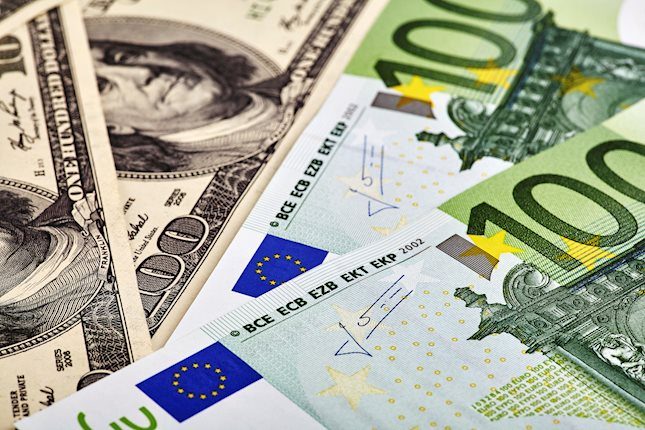
EUR/USD clings to recovery gains near 1.0850 ahead of Fedspeak
EUR/USD trades in positive territory near 1.0850 on Friday following a four-day slide. China's stimulus optimism and a broad US Dollar correction help the pair retrace the dovish ECB decision-induced decline. All eyes remain on the Fedspeak.
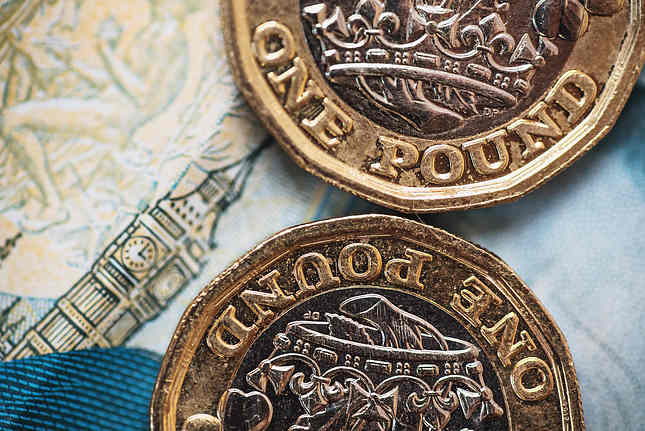
GBP/USD pares UK data-led gains at around 1.3050
GBP/USD is trading at around 1.3050 in the second half of the day on Friday, supported by upbeat UK Retail Sales data and a pullback seen in the US Dollar. Later in the day, comments from Federal Reserve officials will be scrutinized by market participants.

Gold at new record peaks above $2,700 on increased prospects of global easing
Gold (XAU/USD) establishes a foothold above the $2,700 psychological level on Friday after piercing through above this level on the previous day, setting yet another fresh all-time high. Growing prospects of a globally low interest rate environment boost the yellow metal.

Crypto ETF adoption should pick up pace despite slow start, analysts say
Big institutional investors are still wary of allocating funds in Bitcoin spot ETFs, delaying adoption by traditional investors. Demand is expected to increase in the mid-term once institutions open the gates to the crypto asset class.

Canada debates whether to supersize rate cuts
A fourth consecutive Bank of Canada rate cut is expected, but the market senses it will accelerate the move towards neutral policy rates with a 50bp step change. Inflation is finally below target and unemployment is trending higher, but the economy is still growing.
RECOMMENDED LESSONS
Making money in forex is easy if you know how the bankers trade!
Discover how to make money in forex is easy if you know how the bankers trade!
5 Forex News Events You Need To Know
In the fast moving world of currency markets, it is extremely important for new traders to know the list of important forex news...
Top 10 Chart Patterns Every Trader Should Know
Chart patterns are one of the most effective trading tools for a trader. They are pure price-action, and form on the basis of underlying buying and...
7 Ways to Avoid Forex Scams
The forex industry is recently seeing more and more scams. Here are 7 ways to avoid losing your money in such scams: Forex scams are becoming frequent. Michael Greenberg reports on luxurious expenses, including a submarine bought from the money taken from forex traders. Here’s another report of a forex fraud. So, how can we avoid falling in such forex scams?
What Are the 10 Fatal Mistakes Traders Make
Trading is exciting. Trading is hard. Trading is extremely hard. Some say that it takes more than 10,000 hours to master. Others believe that trading is the way to quick riches. They might be both wrong. What is important to know that no matter how experienced you are, mistakes will be part of the trading process.

Best Forex Brokers with Low Spreads
VERIFIED Low spreads are crucial for reducing trading costs. Explore top Forex brokers offering competitive spreads and high leverage. Compare options for EUR/USD, GBP/USD, USD/JPY, and Gold.
